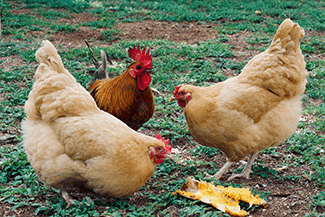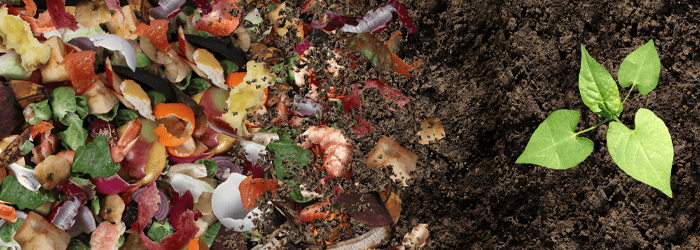#Composting At Home | #Kitchen&YardScrapRecycling
We here at Rosie on the House often get asked about how to reduce waste. We are all about the 3 R’s – Reduce – Reuse – Recycle and so is Farmer Greg Peterson of the Urban Farm which is why he and other special guests like Justin Rohner of Agriscaping share with us their expert advice about #Composting! Learn how you can start to recycle various organic materials – otherwise regarded as waste products – and produces a nutrient rich soil to be used in your gardens. Tune-In to the podcast below for a more in depth discussion!
They have a deep, dark secret at the Urban Farm. It’s the reason their greens spring to life, their flowers are happy, why everything grows so well and the plants are soooo healthy. Visitors to the Urban Farm often notice the thick mulch filling all their garden beds and inquire about their secret. They simply tell everyone, it’s all in the compost.
Could it be that simple? You bet!

Most of the time the heat and desert soils seem to consume organic material faster than we can add it. Building healthy soil by adding compost is the key to growing healthy plants. To compost or not to compost seems to be the question, or better yet how can you easily compost?
Start by looking at the amount of organic material that you have to compost. If all you have are your kitchen scraps, traditional composting may not be your answer, as it requires a lot of organic material, which the typical homeowner generally does not have. Do not fret however, as there are several other ways to “compost” that are much simpler and still accomplish the same results.
So what do you do with your compostable items that won’t require a PhD (stands for pile it higher and deeper) in composting? I call it non-composting and here are just a few suggestions. My favorite way of non-composting is to feed it to the chickens. I know, your first reaction is “I can’t keep chickens in my yard.” Now I am not talking about roosters, just hens and they are very easy to keep, are effective at weeding and controlling bugs, they eat your kitchen and yard scraps, provide lots of great compost material, and give you the added bonus of the occasional egg or two for your breakfast enjoyment.
The basic thing you need to know about chickens is that they like to have a coop area to roost in. I use the coop as a place to contain them for their first month, so that they learn that this yard is their home. Once done they can run wild in your yard if you like; with the caveat that they will eat any new tender plants that are coming up. So I have a designated chicken yard as their living space. There is also the notion of building a chicken tractor (portable chicken coop) that you move around your yard so that the chickens do the work of preparing your beds for planning. As for the kitchen and yard scraps, I just put them in their coop area and the chickens do the composting.
Now if you aren’t quite up for keeping chickens, you might try worms, which are much more innocuous. They do their own kind of digging, provide their own kind of manure and do a really good job of munching on your kitchen scraps. They are as easy to keep as putting a bucket under your sink with some shredded newspapers and worms or, you can add an old bathtub in some corner of your yard and vermicompost (a fancy word for worm composting).

One of my favorite methods of non-composting is called lasagna gardening. It is a process by which you build the soil in your garden and compost at the same time. The name says it all. Start by putting down a layer of dry material usually 1 to 3 inches deep. I like using dried leaves, hay or straw. Then add a layer of manure to facilitate the slow composting, then another layer of dry material and manure. You can add layers to your heart’s content and if you want to plant right away, dig a little hole, add some soil and plant. Over the course of a few months the layers break down and create awesome slow-cooked composted soil. The added bonus, is that you can take your kitchen scraps and tuck them into the lasagna garden and let nature take over.
Now if you still want to take a stab at traditional composting, the first thing to know is that you need a critical mass of organic material in order for the compost process to begin. The minimum size for effective composting is a cube of material 3 x 3 x 3 feet. The organic material used needs to consist of approximately 25% green/nitrogen such as manure, kitchen scraps and green grass clippings and 75% dry/carbon such as dried leaves, hay and chicken yard litter. Next you need to build the pile by thoroughly mixing your items, making sure they are fluffed appropriately so the pile can breath. Then add just enough water so that when you squeeze the wet material like a sponge a little water comes out. Add water once a week and watch the compost happen. A great item to use for building the compost holder is old pallets. Wire three of them together in a “U” shape and add a fourth on the front to hold it all in. This makes harvesting it easy when it is done, as all you have to do is unwire the pallets and use the compost.

The composting process works when bacteria eat the organic material in the pile. This causes heat (and boy does it get hot; up to 160 degrees!). As the bacteria eat the compost, the pile shrinks, up to 50% in just a few weeks. After about six weeks the temperature drops dramatically and the pile needs to be turned and watered and the process starts again. Turn the pile one more time and let it sit for an additional six weeks and you will have wonderful compost. As a general rule, the smaller and more uniform the pieces of material going into the pile the faster the compost will cook.
One of the most abundant materials to use in composting as well as in my non-composting examples is leaves, which fall abundantly in most neighborhoods. Alfalfa hay is high in nitrogen and is another great material to use in your composting and lasagna gardening. When using kitchen scraps I suggest only using vegetable matter as dairy and meat products don’t seem to break down as readily and can attract pests.
Non-composting is easy it just takes some work to get it set up and running. At the Urban Farm composting happens, with chickens, worms, lasagna gardening and traditional composting. The fruits of our labor arrive in great tasting food that we harvest just about every day of the year. Using one or all of these methods just about guarantee you a great crop. Remember though, composting takes time as does raising a great garden. Be patient and compost away.
###
Homeowner Handbook – Outdoor Living To-Do | #Composting #Kitchen&YardScrapRecycling
PODCAST
Justin Rohner of Agriscaping.com discusses the advantages of the Texas Live Oak tree in your landscape. The proper composting mix of greens and browns that make up incredible black gold for gardening. Learn about electroculture gardening, earthing, natural ways to combat allergies and other tips to make gardening a healthy part of your life.
Podcast Archive With Expanded Content and Resources
__________
Composting makes gardens grow, produces food and scraps from that food for more composting. It’s called regenerative design. Farmer Greg Peterson explains different types of composting and other contributors to a compost mix from chickens, worms and soldier flies.
Podcast Archive With Expanded Content and Resources
__________
Farmer Greg’s guest is Zach Brooks of Arizona Worm Farm. A sustainable farm on a mission to take sunshine, rainwater and other people’s garbage to breed and grow worms and insects. Creating rich, nutrient compost and soil for gardens and trees that produce sustainable food. Zach explains everything about worms, his farm and how ‘idiot simple’ it can be.
__________
Farmer Greg has the tips and tricks for making your own compost: he explains the difference between regenerative and sustainability, what a circular composting system looks like and the components for a good compost including the elements that do all the work, the simplest way to make compost and explaining ‘hot composting’. All part of creating healthy soil!
PHOTO CREDIT
- Shutterstock
RELATED CONTENT
















